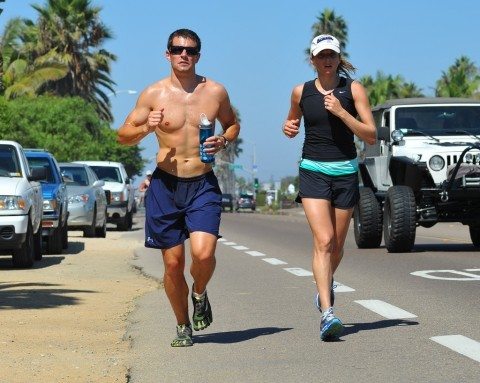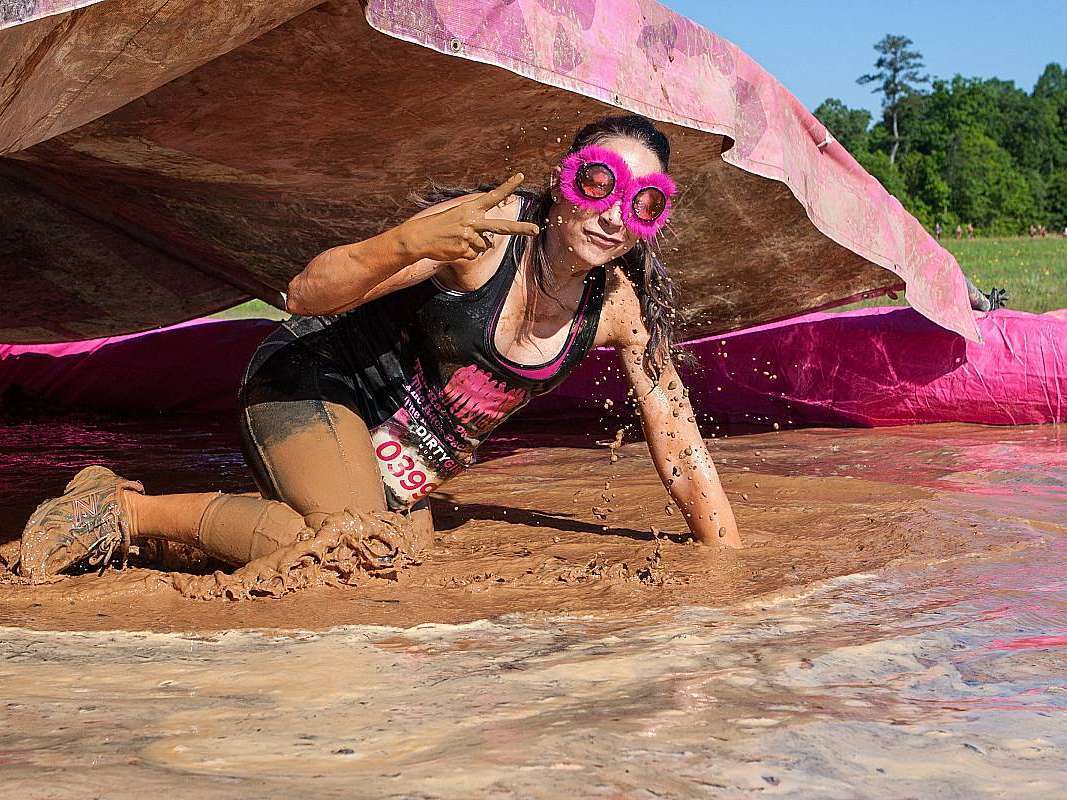Barefoot running shoes are those funky looking running shoes with toes.
You’ve probably seen them. They’re super popular right now.
Serious runners and triathletes have been using them for years.
While Vibram may have started the ball rolling, today there are plenty of shoe manufacturers that have a line of running shoes with toes.
The questions that most runners now have now are:
- “Is there a real reason to separate each toe into its own pocket?“
- “Are barefoot running shoes the best alternative to running barefoot?”
We’ll answer those questions as we explore the top pros and cons of barefoot running shoes, and compare them to the next best thing: minimalist running shoes.
Barefoot Running Shoes PRO: Sensory Feedback
Shoes with toes are definitely a minimalist type of barefoot footwear, but there’s more to them than that.
They’re the closest thing to natural running or running barefoot.
The manufacturers of barefoot running shoes stress the fact that the natural form of the foot is what leads to the best athletic performance. Therefore, by making barefoot shoes, the aim is to put as little between your feet and the ground as possible.
The idea is that you naturally use your feet when you run — to feel the ground, adjust your gait, and determine your stance — based on how rough, smooth, uneven or hard the surfaces you’re running on are.
So the biggest pro, in addition to running as nature intended, is the fact that barefoot runners tend to be more aware of the terrain and their surroundings — largely because they receive more sensory feedback during the course of a run.
Barefoot Running Shoes CON: Limited Protection
The very first ‘natural’ shoes — which barefoot shoes were modeled after — were simple loose leather wraps for the feet. When your feet are covered in simple leather bags (or moccasins), they are easily able to function as they were meant to, and your toes are free to navigate the earth below you.
That’s a good thing. However, just like those early minimalist shoes, there’s no denying the fact that today’s barefoot running shoes offer minimal weather protection and shock protection. That’s the biggest downside to barefoot running shoes: you can’t protect your feet very well against the weather, ground hazards, and injury.
While regular running shoes protect your feet by placing a certain amount of shock absorption between your feet and the ground — so you mostly end up planting your feet the same way no matter what the ground is like — barefoot running shoes offer little to no shock absorption and protection while you’re running.
Today’s barefoot running shoes — or running shoes with toes — do provide something that moccasins and sandals of yesterday didn’t. Instead of locking all your toes into one compartment, they allow each toe to move freely and independently.
Barefoot running shoes serve their purpose well. But they aren’t for everyone.
Another Option: Minimalist Running Shoes
Minimalist running shoes are a hybrid of barefoot running shoes and traditional running shoes.
They’re great for helping you to transition from a traditional cushioned running shoe to a more minimal, natural position by giving your feet the best of both worlds:
- Protection from the harshness of weather and injury
- The ability to sense the ground conditions
Much like barefoot running shoes, most minimalist running shoes are based on the concept of natural motion — without traditional heel cushioning, arch support, or a midsole. With support only where it’s needed, the foot is allowed to move the way nature designed it to.
By slowly and gradually incorporating minimalist running shoes into your training routine, you will improve the strength in your legs and feet. Over time, you will become a stronger runner.
When you’re researching minimalist running shoes, you should look for these 5 features:
- They should have lightweight, flexible uppers — because your feet are flexible and dynamic and they need to be able to move in every way they want. The foot should be able to flex up & down and spread out, in order to operate naturally without feeling confined.
- They should have minimal heel-to-toe drop (generally 4mm to 9mm) — because you want the most underfoot feel possible. In comparison, traditional running shoes typically have a 10mm to 12mm drop from the heel to the toe, while barefoot running shoes are usually 0mm to 3mm.
- They should have a thin outsole / underfoot material so your feet can completely feel the ground – because your running performance is improved with more sensory feedback. In minimalist running shoes, the outsole thickness falls anywhere from 3mm to 9mm.
- They should have a large toebox to give each of your toes the freedom to move and operate on its own — because your feet have toes for a reason; and they should be able to grip and feel as you run.
- They should be lightweight overall — because any extra weight impacts your gait and stride. Remember, the ultimate goal is to feel like your barely wearing shoes at all.
Fortunately, today’s minimalist shoe manufacturers are designing footwear that addresses each those factors.
Some minimalist shoe brands:
- Merrell
- Vibram
- BIOM
- Vivobarefoot
- inov-8
- Nike
- ZEMGear
- Brooks
- Saucony
- New Balance
- Adidas
There’s no doubt about it, most runners will experiment with minimalist running shoes at some point — either barefoot running shoes with toes or a hybrid version.
When you do, you’ll immediately appreciate how much more aware you’ll be as a runner. And eventually, you’ll become a much stronger runner.
Two things to keep in mind:
#1 – Not all shoes with toes are barefoot running shoes. Fila Skele-toes, for instance, do give your toes their own compartments, but they’re made of stiff, inflexible rubber. They miss the whole point of barefoot running shoes.
#2 – Not all minimalist running shoes are truly minimalist in design. It’s a popular trend that shoe makers want to be a part of, so many will slap their label on shoes and call them minimalist. As long as you seek out the 5 features mentioned above, you’ll find shoes that really are the best minimalist shoes for runners.
The white-hot phase of the minimalist running movement, when many runners went directly from conventional shoes to barely there models, is over. The advice to gradually transition to lower, lighter shoes has been commonly accepted; a new study adds support to the wisdom of such a transition. — Runners World
More About Minimalist Running Shoes
- How To Choose Running Shoes: Tips From A Triathlete
- Barefoot/Minimalist Running Basics From REI
- How Barefoot Running Shoes Work
- Barefoot Shoes: Ratings For The Top Minimalist Shoes
- How To Choose Barefoot/Minimalist Running Shoes
- Tips For Getting Started In Minimalist Running Shoes
- Barefoot Running Shoes Reviewed
- Running Barefooted: Parts 1-5 From A Running Coach





